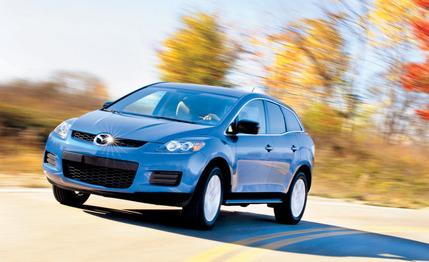
 Long-Term Road Test
Long-Term Road Test
Mazda adapted to the U.S. car-buying public’s desire for lighter and more agile carlike “crossovers”—a slightly encouraging shift away from large, heavy gas-guzzling SUVs—by launching the five-passenger CX-7 for 2007. The similarly spacious and even more carlike Mazda 6 wagon, possibly having been shunned because it contained the terminally uncool term “wagon” in its name, got the ax for 2008.
Based largely on existing Mazda car architecture, but with distinctive styling and very un-SUV-like road manners, a CX-7 joined our long-term fleet. Powered by a 244-hp version of the turbocharged four-cylinder also used in the Mazdaspeed 3 and 6, we were curious to find out if the mid-size ute could produce V-6 oomph with four-cylinder fuel economy.
A CX-7 starts at $24,310, including standard stability control, six airbags, and 18-inch wheels, but we cranked up the sticker by 32 percent with options, checking out at $32,195. The mid-level Touring model is a $1750 premium (leather steering wheel, heated leather front seats, and power driver’s seat), and we added all-wheel drive ($1700), the $4005 Technology package (sunroof, six-CD changer, Bose nine-speaker stereo, navigation, rearview camera, and keyless starting), and Sirius satellite radio ($430), which includes a six-month subscription.
We were immediately taken with the CX-7’s affable road manners. Aside from excellent straight-line stability, we lauded the Mazda’s “perfectly weighted and responsive steering” and “playful chassis” with an almost rear-wheel-drive feel that gives it nimbleness absent from nearly every other vehicle in its class. One driver summed this up as “an SUV doing a rally-car impersonation.”
The superior behind-the-wheel performance wasn’t purely about the numbers, as the Mazda pulled a somewhat ordinary stability-control-limited 0.80 g on the skidpad. (The system can only be switched off below 20 mph.) But the particularly pleasing pulsing of the anti-lock brakes—among the smoothest-operating systems we’ve sampled—led to stops verging on sports-car levels, from 70 mph to a standstill in as few as 167 feet.
Part of the CX-7’s agility is certainly due to its admirably low 3916-pound curb weight. That’s 612 pounds lighter than its slightly larger corporate cousin, the Ford Edge—no wonder the Ford can’t mambo like the Mazda—and also a few hundred pounds lighter than two perennial bestsellers in this category, the Honda Pilot and the Toyota Highlander (although those two offer a third-row seat). Everything comes with a trade-off, however, and staffers commented that noise levels from the road and wind were higher than expected.
Negativity also arose from dealings with the CX-7’s six-speed automatic—why can’t we get the six-speed manual available elsewhere?—that regularly upshifted before we thought necessary (to improve fuel economy, no doubt) and was stingy with downshifts as well. And at 32 grand, it’s surprising that our Mazda didn’t display outside temperature or fuel economy.